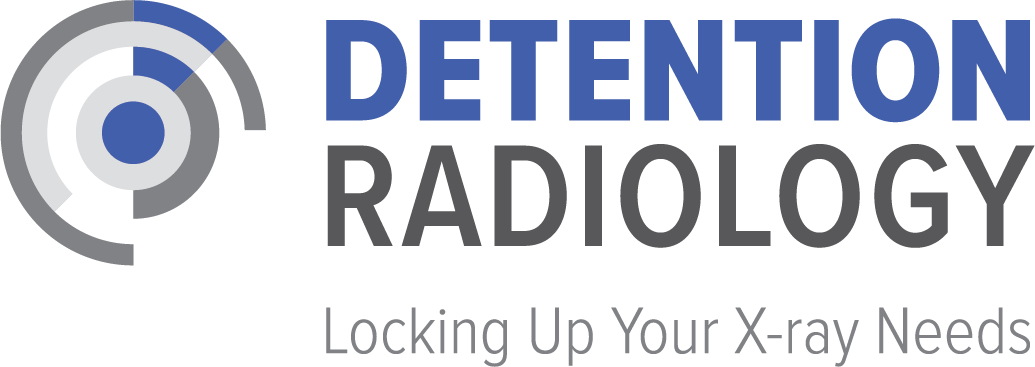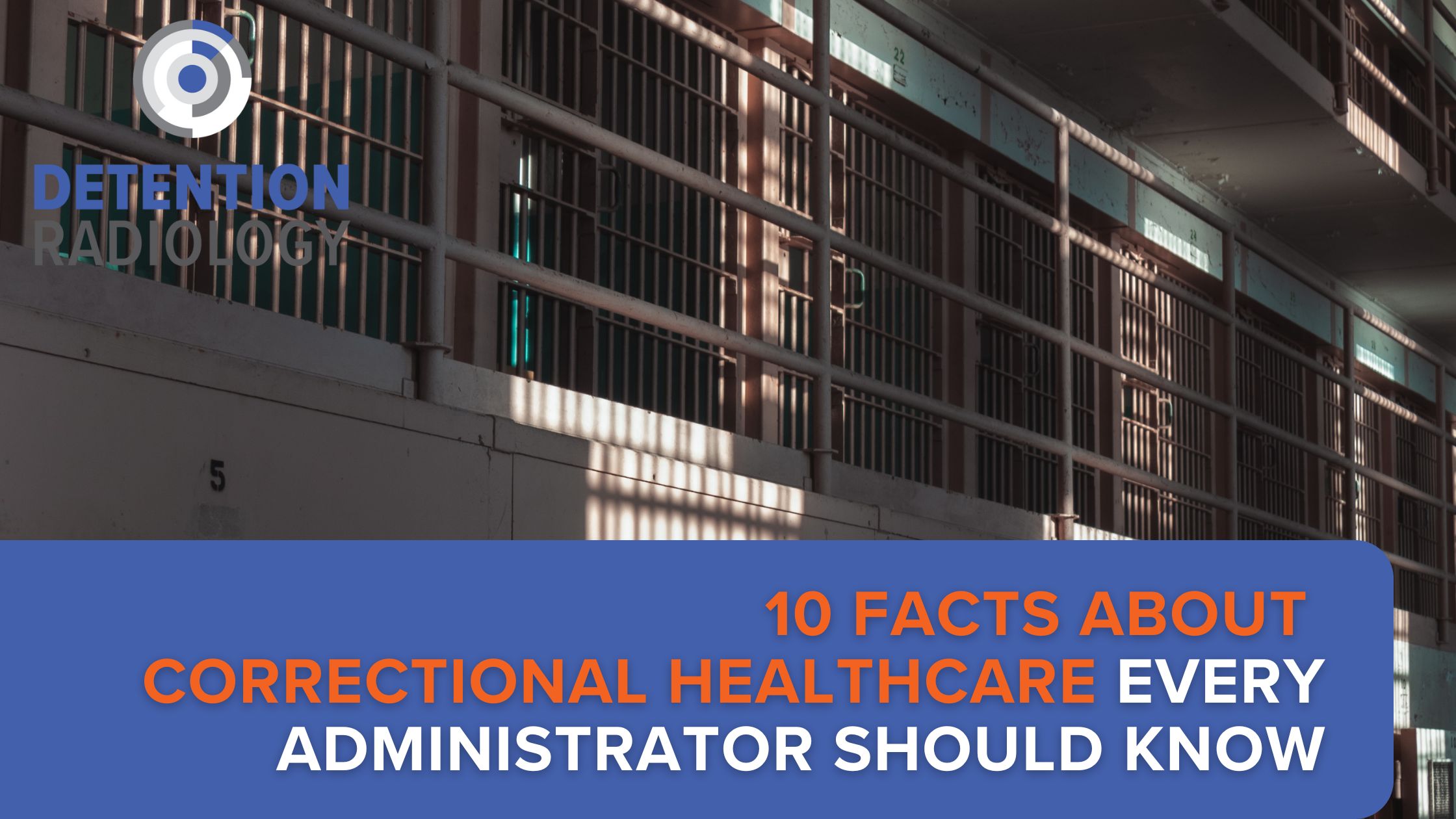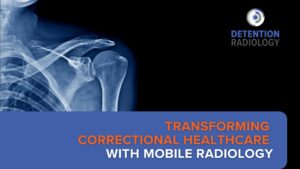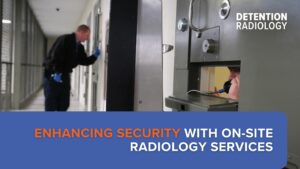Correctional healthcare is one of the most complex and high-stakes responsibilities within the justice system. Facility administrators, Directors of Nursing (DONs), and medical staff are charged with delivering care to a population with disproportionately high rates of chronic disease, mental illness, and untreated conditions—all under tight regulatory scrutiny and security constraints.
This blog outlines essential correctional healthcare facts that every administrator should understand—and how Detention Radiology’s on-site imaging services help detention centers meet the demand for faster, safer, and more compliant care.
1. Nearly 40% of Inmates Have a Chronic Illness
According to the Bureau of Justice Statistics, approximately 4 in 10 incarcerated individuals live with conditions like diabetes, hypertension, or heart disease. Early diagnosis and routine monitoring are critical—and imaging plays a key role in that care.
“Chronic care management begins with proper diagnostics,” says Tyler Merchant, Director at Detention Radiology. “That’s why on-site X-ray services are a game changer for correctional teams trying to stay ahead of complications.”
2. The Risk of Delayed Diagnostics Is High in Detention Settings
When inmates wait days or weeks for imaging due to transport delays or hospital scheduling, their conditions often worsen—putting them, the facility, and medical staff at greater risk.
Detention Radiology eliminates that delay by offering same-day on-site X-rays, allowing providers to act quickly and effectively.
3. Transporting Inmates for Imaging Increases Security and Budget Risk
Each off-site appointment requires correctional officers, vehicles, and logistical planning. It also increases risk to public safety and staff. That’s why many facilities now use on-site imaging to significantly reduce inmate transport costs and liability.
📖 Learn more in our blog: How On-Site X-Ray Services Reduce Inmate Transport Costs
4. Tuberculosis Remains a Public Health Concern in Correctional Facilities
TB screening is essential—especially at intake—and chest X-rays are a critical tool in early detection. Facilities that delay or skip this process risk audit findings, outbreaks, and public health violations.
On-site chest X-rays from Detention Radiology support same-day screening protocols and help facilities meet NCCHC and DOJ compliance standards.
5. Mental Health Diagnoses Are Common—But Often Overlook Physical Trauma
More than half of incarcerated individuals have mental health concerns, and many arrive with undiagnosed physical injuries tied to substance use, accidents, or assault. Radiology services can help uncover the root cause of symptoms like confusion, dizziness, or pain.
6. Correctional Healthcare Providers Are Often Understaffed
Limited personnel means every wasted hour counts. Facilities need streamlined services that minimize paperwork, reduce outside scheduling, and integrate directly with EMRs.
That’s exactly what Detention Radiology delivers with on-site imaging that’s efficient, secure, and documentation-ready.
7. Legal Action Related to Inadequate Care Is on the Rise
Healthcare is one of the most common sources of inmate litigation. Delays in diagnosis, poor documentation, and failure to follow up with care are frequent triggers. On-site imaging services provide faster care and the digital proof needed to protect your facility and staff.
8. Same-Day Diagnostics Improve Inmate Outcomes
Whether it’s confirming a fracture, identifying pneumonia, or investigating abdominal pain, fast diagnostics lead to faster treatment—which improves outcomes and reduces emergency hospitalizations.
9. Correctional Healthcare Impacts Community Health
When inmates return to the community, their untreated or undiagnosed conditions become public health concerns. Facilities that invest in preventive care—like on-site X-rays for screenings and early interventions—protect not just the incarcerated population, but the broader public.
10. Investing in On-Site Imaging Supports Operational and Ethical Goals
At its core, providing healthcare in detention settings is both a legal obligation and a moral responsibility. Partnering with a specialized provider like Detention Radiology ensures your team can meet both with integrity, efficiency, and professionalism.
How Detention Radiology Helps You Act on These Correctional Healthcare Facts
Detention Radiology was built specifically for the correctional environment. Our services are not a hospital add-on—we specialize in secure, responsive, and compliant on-site imaging designed for jails, prisons, and detention centers.
What We Offer:
- Same-day on-site X-rays, ultrasounds, and echocardiograms
- Digital report delivery and EMR integration
- HIPAA, DOJ, and NCCHC compliant protocols
- Trained staff who understand the correctional healthcare environment
- Female-owned business, ready for contract eligibility
Final Thoughts: The Correctional Healthcare Facts Demand Action
Correctional administrators and healthcare leaders face enormous challenges every day—but those challenges come with an opportunity. Facilities that take a proactive approach to inmate healthcare, backed by fast and compliant diagnostic tools, reduce risks and build a better system of care.
“When we show up with an X-ray machine, we’re not just bringing equipment—we’re bringing peace of mind,” says Merchant.
📍 Take the next step toward better care and operational efficiency.
Learn more at: https://detentionradiology.com/






